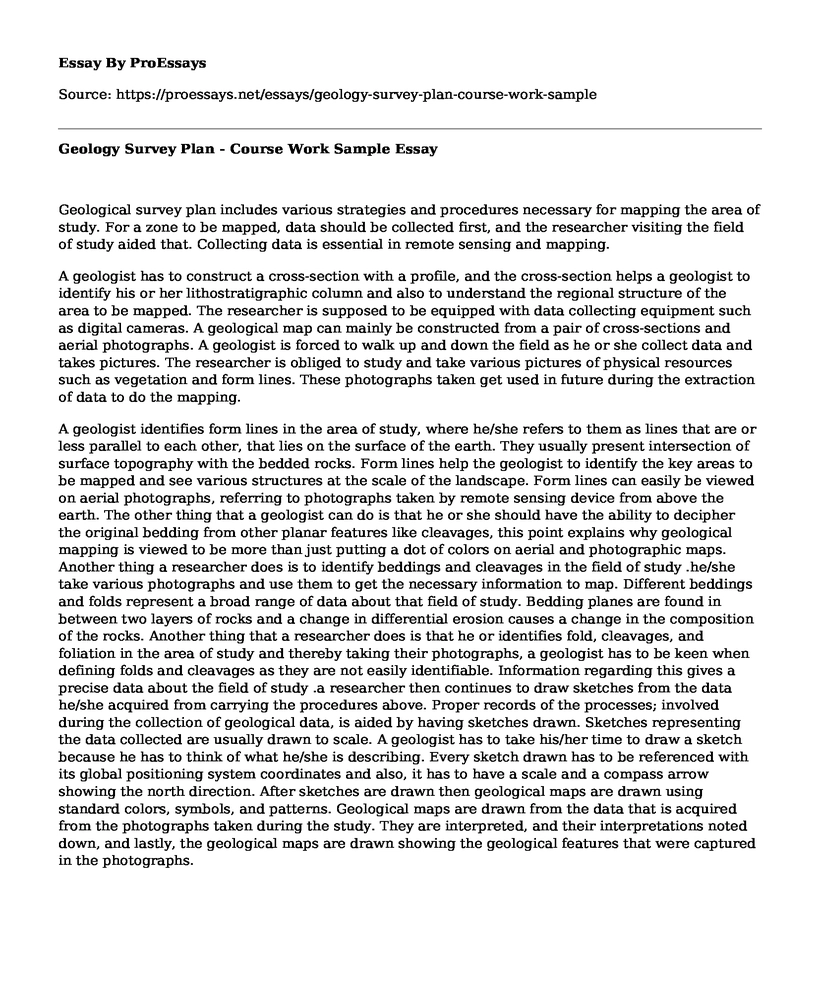Geological survey plan includes various strategies and procedures necessary for mapping the area of study. For a zone to be mapped, data should be collected first, and the researcher visiting the field of study aided that. Collecting data is essential in remote sensing and mapping.
A geologist has to construct a cross-section with a profile, and the cross-section helps a geologist to identify his or her lithostratigraphic column and also to understand the regional structure of the area to be mapped. The researcher is supposed to be equipped with data collecting equipment such as digital cameras. A geological map can mainly be constructed from a pair of cross-sections and aerial photographs. A geologist is forced to walk up and down the field as he or she collect data and takes pictures. The researcher is obliged to study and take various pictures of physical resources such as vegetation and form lines. These photographs taken get used in future during the extraction of data to do the mapping.
A geologist identifies form lines in the area of study, where he/she refers to them as lines that are or less parallel to each other, that lies on the surface of the earth. They usually present intersection of surface topography with the bedded rocks. Form lines help the geologist to identify the key areas to be mapped and see various structures at the scale of the landscape. Form lines can easily be viewed on aerial photographs, referring to photographs taken by remote sensing device from above the earth. The other thing that a geologist can do is that he or she should have the ability to decipher the original bedding from other planar features like cleavages, this point explains why geological mapping is viewed to be more than just putting a dot of colors on aerial and photographic maps. Another thing a researcher does is to identify beddings and cleavages in the field of study .he/she take various photographs and use them to get the necessary information to map. Different beddings and folds represent a broad range of data about that field of study. Bedding planes are found in between two layers of rocks and a change in differential erosion causes a change in the composition of the rocks. Another thing that a researcher does is that he or identifies fold, cleavages, and foliation in the area of study and thereby taking their photographs, a geologist has to be keen when defining folds and cleavages as they are not easily identifiable. Information regarding this gives a precise data about the field of study .a researcher then continues to draw sketches from the data he/she acquired from carrying the procedures above. Proper records of the processes; involved during the collection of geological data, is aided by having sketches drawn. Sketches representing the data collected are usually drawn to scale. A geologist has to take his/her time to draw a sketch because he has to think of what he/she is describing. Every sketch drawn has to be referenced with its global positioning system coordinates and also, it has to have a scale and a compass arrow showing the north direction. After sketches are drawn then geological maps are drawn using standard colors, symbols, and patterns. Geological maps are drawn from the data that is acquired from the photographs taken during the study. They are interpreted, and their interpretations noted down, and lastly, the geological maps are drawn showing the geological features that were captured in the photographs.
Cite this page
Geology Survey Plan - Course Work Sample. (2021, Apr 14). Retrieved from https://proessays.net/essays/geology-survey-plan-course-work-sample
If you are the original author of this essay and no longer wish to have it published on the ProEssays website, please click below to request its removal:
- Personal Statement Example: Designing and Developing a Three Phase Electrical System
- Research Paper on Applied Trigonometry and Geometry
- The Dominican Republic - Research Paper
- Thermodynamics Fundamentals Paper Example
- Laboratory Report on CAT Hydroelectric Power Experiment Paper Example
- How A Spring Works and the Physics Behind It - Research Paper
- Formation of Caves: Exploring Limestone Dissolution - Essay Sample







